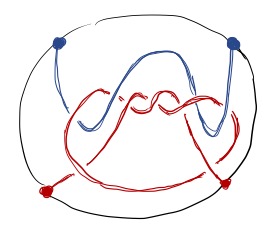Let $\mathbb{H}^3:=\operatorname{SO}(3,1)/\operatorname{O(3)}$. Is there a lattice $\Gamma$ in $\operatorname{SO}(3,1)$ such that \begin{equation} X:=\mathbb{H}^3/\Gamma \end{equation} is contractible? Of course, we need to assume that $\Gamma$ has torsion.
-
1$\begingroup$ I guess it’s a typo. SO(3) in place of SO(1) will be fine. $\endgroup$– ThiKuCommented Nov 28, 2022 at 6:39
-
1$\begingroup$ It is a typo. I have edited the questions. $\endgroup$– David.DCommented Nov 28, 2022 at 7:50
-
1$\begingroup$ It is true that I am not very familiar with hyperbolic geometry. I copied the above description from wikipedia without checking. The version I am interested in is $\operatorname{SO}^\circ(3,1)/\operatorname{SO}(3)$ where $\operatorname{SO}^\circ(3,1)$ is the connected component that contains the identity. $\endgroup$– David.DCommented Nov 28, 2022 at 14:15
-
1$\begingroup$ @Moishe Kohan: Most people think of hyperbolic space as a concrete model, say upper half space or disk model. The notation as a homogeneous space is then just a short way to define it. $\endgroup$– ThiKuCommented Nov 28, 2022 at 18:49
-
3$\begingroup$ @MoisheKohan - could I ask you (pretty please!) to (try to) avoid "biting the hyperbolic geometry newbies"? Thank you! $\endgroup$– Sam NeadCommented Nov 28, 2022 at 21:59
2 Answers
Yes. For example, let $M$ be the figure-eight knot complement. So $M$ is a hyperbolic manifold with volume a bit more than 2. The manifold $M$ has a two-fold symmetry $\tau$ that fixes, pointwise, a pair of geodesics $\alpha$ and $\beta$. The symmetry $\tau$ extends over the figure-eight knot to give an isometry of $S^3$. In $S^3$ the arcs $\alpha$ and $\beta$ (together with two points of the knot) form a great circle - $\tau$ is a 180 degree rotation about this great circle.
We take the boundary of a small regular neighbourhood of the figure eight to get a "cusp torus". This torus meets the great circle in four points. The quotient of the cusp torus is a euclidean orbifold of type $S^2(2, 2, 2, 2)$. Using the above, we find that $M/\tau$ is homeomorphic to an open ball; the images of $\alpha$ and $\beta$ are the orbifold locus in $M/\tau$ and "look like" a tangle in the open ball. Here is a picture of what I get this way:
EDIT: Every orientable hyperbolic orbifold, with contractible underlying space, is essentially of this "type". That is, it is a labelled graph embedded in the open three-ball.
To see this: tameness and contractibility implies that the boundary is a single two-sphere and the underlying manifold is an open three-ball. Since $\Gamma$ is a lattice it has finite covolume. Thus the number of cone points in the boundary orbifold is either three or four. Their markings make the boundary into a euclidean orbifold. The orbifold locus in the interior of the three-ball may have vertices - the boundary of a regular neighbourhood of any of these is a spherical orbifold.
In the example above, there are no internal vertices, and the boundary orbifold is $S^2(2, 2, 2, 2)$.
I vaguely remember a paper of Hatcher's that lists the first few (arithmetic?) hyperbolic orbifolds. [EDIT: Here is a link to that paper (now that Hatcher has kindly reminded me of the title).]
-
1$\begingroup$ Why is it clear that an orbifold with boundary a sphere must be a ball? Because of irreducubility? $\endgroup$– ThiKuCommented Nov 27, 2022 at 21:26
-
$\begingroup$ I've added several sentences to explain why this holds in my particular example (the quotient of the figure-eight knot). This also holds "in general" and it follows from tameness - I've added a short sketch. $\endgroup$– Sam NeadCommented Nov 28, 2022 at 15:31
-
3$\begingroup$ The unpublished paper of mine that Sam Need refers to is "Bianchi orbifolds of small discriminant", available on the arXiv. It includes six examples of hyperbolic orbifolds homeomorphic to ${\mathbb R}^3$, the quotients ${\mathbb H}^3/PGL(2,O_d)$ for $O_d$ the ring of integers in the quadratic extension of ${\mathbb Q}$ of discriminant $d$ for $d=-3,-4,-7,-8,-11,-19$. These examples rely on computer calculations by Robert Riley from the 1970s. In each case the singular locus of the orbifold contains points with noncyclic stabilizers, so these examples are different from Sam Need's example. $\endgroup$ Commented Nov 29, 2022 at 2:15
As pointed out by Moishe Kohan in the comments below, the following doesn't answer the question as asked, because my group $\Gamma$ is not contained in $SO(3,1)$. Anyway, here is an easy description of a $\Gamma$ that contains orientation-reversing elements that has all the other properties that are asked for.
By the intermediate value theorem, there is a regular dodecahedron in hyperbolic 3-space whose dihedral angles are all $90^\circ$. (The angles for a Euclidean regular dodecahedron are greater than $90^\circ$ and the angles for an ideal regular dodecahedron are $60^\circ$.) The group generated by the reflections in the sides of this dodecahedron is a discrete group $\Gamma$ with the property that $\mathbb{H}/\Gamma$ is contractible, since it's just a copy of the dodecahedron.
-
$\begingroup$ Is it easy to see that no points on different faces become identified? $\endgroup$ Commented Nov 28, 2022 at 16:57
-
1$\begingroup$ If you look closely, OP assumes that the lattice preserves orientation. Otherwise, it is a valid solution. $\endgroup$ Commented Nov 28, 2022 at 17:04
-
1$\begingroup$ You're right. Thanks. I'll edit my solution to point out that it has this flaw later. $\endgroup$– IJLCommented Nov 28, 2022 at 17:25

